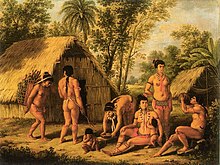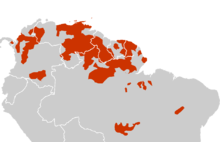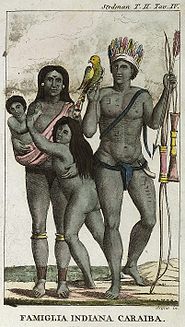|
Kalinago
 The Kalinago, also called Island Caribs[5] or simply Caribs, are an Indigenous people of the Lesser Antilles in the Caribbean. They may have been related to the Mainland Caribs (Kalina) of South America, but they spoke an unrelated language known as Kalinago or Island Carib. They also spoke a pidgin language associated with the Mainland Caribs.[6] At the time of Spanish contact, the Kalinago were one of the dominant groups in the Caribbean (the name of which is derived from "Carib", as the Kalinago were once called). They lived throughout north-eastern South America, Trinidad and Tobago, Barbados, the Windward Islands, Dominica, and possibly the southern Leeward Islands. Historically, it was thought their ancestors were mainland peoples who had conquered the islands from their previous inhabitants, the Igneri. However, linguistic and archaeological evidence contradicts the notion of a mass emigration and conquest; the Kalinago language appears not to have been Cariban, but like that of their neighbors, the Taíno. Irving Rouse and others suggest that a smaller group of mainland peoples migrated to the islands without displacing their inhabitants, eventually adopting the local language but retaining their traditions of a South American origin.[7] In the early colonial period, the Kalinago had a reputation as warriors who raided neighboring islands. According to the tales of Spanish conquistadors, the Kalinago were cannibals who regularly ate roasted human flesh,[8] although this is considered by the community to be an offensive myth. There is no hard evidence of Caribs eating human flesh, though one historian points out it might be useful to frighten enemy Arawak.[9][10] The Kalinago and their descendants continue to live in the Antilles, notably on the island of Dominica. The Garifuna, who share common ancestry with the Kalinago, also live principally in Central America. NameThe exonym Caribe was first recorded by Christopher Columbus.[11]: vi One hypothesis for the origin of Carib is that it means "brave warrior".[11]: vi Its variants, including the English word Carib, were then adopted by other European languages.[11]: vi Early Spanish explorers and administrators used the terms Arawak and Caribs to distinguish the peoples of the Caribbean, with Carib reserved for Indigenous groups that they considered hostile and Arawak for groups that they considered friendly.[12]: 121 The Kalinago language endonyms are Karifuna (singular) and Kalinago (plural).[13][14] The name was officially changed from 'Carib' to 'Kalinago' in Dominica in 2015.[15][16] HistoryWilliam F. Keegan and Corinne L. Hofman have outlined two major models for the origin of the Kalinago.[17] The traditional account, which is almost as old as Columbus, says that the Caribs were a warlike people who were moving up the Lesser Antilles and displacing the original inhabitants.[17][18] Early missionary texts suggested the original inhabitants of the islands were the Igneri, while the Kalinago were invaders originating in South America (home to the mainland Caribs or Kalina) who conquered and displaced the Igneri.[19] As this tradition was widespread in oral testimonies, and internally consistent, it was accepted as historical by Europeans.[20][21] The second model proposes that the Kalinago developed out of the indigenous peoples of the Antilles.[17] While the Caribs were commonly believed to have migrated from the Orinoco River area in South America to settle in the Caribbean islands about 1200 CE, an analysis of ancient DNA suggests that the Caribs had a common origin with contemporary groups in the Greater and Lesser Antilles.[22] The transition from Igneri to Island Carib culture may have occurred around 1450.[23] Archaeological evidence in support of either model is sparse, with "no confirmed Carib sites [known] prior to the 1990s."[17] However, Cayo-style pottery found in the Lesser Antilles, and dated between 1000 and 1500, is similar to the Koriabo complex from which the mainland Carib or Kari'na pottery tradition is descended. Cayo pottery was once thought to have preceded Suazoid pottery (associated with the Igneri) in the Lesser Antilles, but more recent scholarship suggests that Cayo pottery gradually replaced Suazoid pottery in the islands.[17] Cayo-style pottery has been found in the Lesser Antilles from Grenada to Basse-Terre, and, possibly, Saint Kitts. Cayo pottery also shows similarities to the Meillacoid and Chicoid styles of the Greater Antilles, as well as to the South American Koriabo style.[24] Arrival of ColumbusUpon his arrival in the Caribbean archipelago in 1492, the Maipurean-speaking Taínos reportedly told Christopher Columbus that Caribs were fierce warriors and cannibals, who made frequent raids on the Taínos, often capturing women.[21][25] According to Columbus, the Taínos said the Caribs had spent the last two centuries displacing the Taínos by warfare, extermination, and assimilation.[26]  The French missionary Raymond Breton arrived in the Lesser Antilles in 1635, and lived in Guadeloupe and Dominica until 1653. He took ethnographic and linguistic notes on the native peoples of these islands, including St. Vincent, which he visited briefly. Breton was responsible for many of the early stereotypes about Kalinago.[27] Later, the Kalinago occasionally allied with the Taínos to repel European invaders. When the Spanish attempted to colonize Puerto Rico, Kalinago from St. Croix arrived to aid the local Taíno.[28] Daguao village, initially slated to be the Europeans' new capital, was destroyed by Taínos from the eastern area of Puerto Rico, with the support of Kalinago from neighboring Vieques.[29] By the middle of the 16th century, the resistance of Taínos and Kalinago alike was largely quashed across the Greater Antilles. The survivors were enslaved to work in agriculture or mining.[12] The Kalinagos were more successful in repelling the Spanish—and later the French and English—in the Lesser Antilles, retaining their independence. The lack of gold in the area and the large numbers of casualties inflicted upon the Spanish contributed to their survival.[12] Resistance to the English and the French In the seventeenth century, the Kalinago regularly attacked the plantations of the English and the French in the Leeward Islands. In the 1630s, planters from the Leewards conducted campaigns against the Kalinago, but with limited success. The Kalinago took advantage of divisions between the Europeans, to provide support to the French and the Dutch during wars in the 1650s, consolidating their independence as a result.[30] Such wars led to a geopolitical boundary separating the Lesser Antilles, inhabited by the Kalinago, from the Greater Antilles, inhabited by the Taíno. This boundary became known as the "poison arrow curtain".[12][31] In 1660, France and England signed the Treaty of Saint Charles with Island Caribs. It stipulated that the Kalinago would evacuate all the Lesser Antilles except for Dominica and Saint Vincent, which were recognised as reserves. However, the English later ignored the treaty, and pursue a campaign against the Kalinago in succeeding decades.[32] Between the 1660s and 1700, the English waged an intermittent campaign against the Kalinago.[6] By 1763, the British had annexed St Lucia, Tobago, Dominica and St Vincent.[30] On Saint Vincent the Kalinago intermarried with runaway slaves, forming the ‘Black Caribs’ or Garifuna who were expelled to Honduras in 1797. The British colonial use of the term Black Carib, particularly in William Young's Account of the Black Charaibs (1795), has been described in modern historiography as framing the majority of the indigenous St. Vincent population as "mere interlopers from Africa" who lacked claims to land possession in St. Vincent.[12]: 121–123 [33]: 182 On Dominica the runaways formed distinct Maroon communities while the Caribs remained distinct. A remnant of these Caribs lives on in the Kalinago Territory.[citation needed] Kalinago people today  As of 2008[update], a small population of around 3,400 Kalinago survived in the Kalinago Territory in northeast Dominica, of whom some 70 "defined themselves as 'pure'".[35] The Kalinago of Dominica maintained their independence for many years by taking advantage of the island's rugged terrain. The island's east coast includes a 3,700-acre (15 km2) territory formerly known as the Carib Territory that was granted to the people by the British government in 1903. The Dominican Kalinago elect their own chief. In July 2003, the Kalinago observed 100 Years of Territory, and in July 2014, Charles Williams was elected Kalinago Chief, succeeding Chief Garnette Joseph.[36] Several hundred Carib descendants live in the U. S. Virgin Islands, St. Kitts & Nevis, Antigua & Barbuda, Guadeloupe, Martinique, Dominica, Saint Lucia, Grenada, Trinidad and St. Vincent. "Black Caribs," the descendants of the mixture of Africans live in St. Vincent whose total population is unknown. Some ethnic Carib communities remain on the American mainland, in countries such as Guyana and Suriname in South America, and Belize in Central America. The size of these communities varies widely.[citation needed] During the beginning of the eighteenth century, the Island Carib population in St. Vincent was greater than that in Dominica. Both the Island Caribs (Yellow Caribs) and the Black Caribs (Garifuna) fought against the British during the Second Carib War. After the end of the war, the British deported the Garifuna (a population of 4,338) to Roatan Island, while the Island Caribs (whose population consisted of 80 people) were allowed to stay on St. Vincent.[37] The 1812 eruption of La Soufrière destroyed the Carib territory, killing a majority of the Yellow Caribs. After the eruption, 130 Yellow Caribs and 59 Black Caribs survived on St. Vincent. Unable to recover from the damage caused by the eruption, 120 of the Yellow Caribs, under Captain Baptiste, emigrated to Trinidad. In 1830, the Carib population numbered less than 100.[38][39] The population made a remarkable recovery after that, although almost the entire tribe died out during the 1902 eruption of La Soufrière.[citation needed] Culture and societyCanoesCanoes are a significant aspect of the Kalinago's material culture and economy. They are used for transport from the southern continent and islands of the Caribbean, as well as providing them with the ability to fish more efficiently and to grow their fishing industry.[40] Canoes, constructed from the Burseraceae, Cedrela odorata, Ceiba pentandra, and Hymenaea courbaril trees, serve different purposes depending on their height and thickness of the bark. The Ceiba pentandra tree is not only functional but spiritual and believed to house spirits that would become angered if disturbed.[41] Canoes have been used throughout the history of the Kalinago and have become a renewed interest within the manufacturing of traditional dugout canoes used for inter-island transportation and fishing.[42] In 1997 Dominica Carib artist Jacob Frederick and Tortola artist Aragorn Dick Read set out to build a traditional canoe based on the fishing canoes still used in Dominica, Guadeloupe and Martinique. They launched a voyage by canoe to the Orinoco delta to meet up with the local Kalinago tribes, re-establishing cultural connections with the remaining Kalinago communities along the island chain, documented by the BBC in The Quest of the Carib Canoe.[43] LanguageHistorically, scholars assumed that Island Carib men and women spoke different languages. To explain this phenomenon, scholars proposed that the Island Caribs may have killed the men and kept the women, allowing the Igneri language to survive among women.[44] This assumption arose from the fact that by at least the early 17th century, Carib men spoke a Cariban-based pidgin language in addition to the usual Arawakan language used by both sexes. This was similar to pidgins used by mainland Caribs when communicating with their Arawak neighbors. Berend J. Hoff and Douglas Taylor hypothesized that it dated to the time of the Carib expansion through the islands, and that males maintained it to emphasize their origins on the mainland.[45] Linguistic analysis in the 20th century determined that the main Island Carib language was spoken by both sexes, and was Arawakan, not Cariban. Scholars adopted more nuanced theories to explain the transition from the earlier Igneri to the later Island Carib societies in the Antilles. Irving Rouse proposed that a relatively small scale Carib force conquered but did not displace the Igneri, and the invaders eventually took on the Igneri language while still maintaining their identity as Caribs.[45] Other scholars such as Sued Badillo doubt there was an invasion at all, proposing that the Igneri adopted the "Carib" identity over time due to their close economic and political relations with the rising mainland Carib polity.[46] Both theories accept that the historical Island Carib language developed from the existing tongue of the islands, and thus it is also known as Igneri.[47] MedicineBy the early twenty-first century, a combination of bush medicine and modern medicine was used by the Kalinago of Dominica. For example, various fruits and leaves are used to heal common ailments. For a sprain, oils from coconuts, snakes, and bay leaves are used to heal the injury.[dubious – discuss] Formerly the Caribs used an extensive range of medicinal plant and animal products.[48] ReligionThe Caribs are believed to have practiced polytheism. As the Spanish began to colonise the Caribbean area, they wanted to convert the natives to Catholicism.[49] The Caribs destroyed a church of Franciscans in Aguada, Puerto Rico and killed five of its members, in 1579.[50] Currently, the remaining Kalinago in Dominica practice parts of Catholicism through baptism of children. However, not all practice Christianity. Some Caribs worship their ancestors and believe them to have magical power over their crops.[citation needed] RepresentationIn 1492, when Christopher Columbus arrived in the Caribbean, the Maipurean-speaking Taínos reportedly relayed stories of the Caribs' war-like nature and cannibalism to him.[21][25][26] When he arrived in the Lesser Antilles in 1635, the French missionary Raymond Breton made ethnographic and linguistic notes on the "Caribs", which also informed many of the early stereotypes about the Kalinago.[27] Other missionaries, such as Cesar de Rochefort, would refute the common conception of the Caribs as cannibals.[51] CannibalismEarly European accounts describe the taking of human trophies and the ritual cannibalism of war captives among both Arawak and other Amerindian groups such as the Carib and Tupinambá, though the exact accuracy of cannibalistic reports still remains debated without skeletal evidence to support it.[52][53][10] Scholars such as Hilary McD. Beckles have instead suggested that the stories of "vicious cannibals" may have comprised an "ideological campaign" against the Kalinago to justify "genocidal military expeditions" by European colonizers.[28] The Island Carib word karibna meant "person", although it became the origin of the English word "cannibal" after Columbus shared stories of flesh-eating Kalinago, apparently heard from their historic Taíno enemies.[54][26] Among the Caribs, karibna was apparently associated with ritual eating of war enemies.[52][53] The Caribs reportedly had a tradition of keeping bones of their ancestors in their houses. Missionaries, such as Père Jean Baptiste Labat and Cesar de Rochefort, described the practice as part of a belief that the ancestral spirits would always look after the bones and protect their descendants. The Caribs have been described by their various enemies as vicious and violent raiders. Rochefort stated they did not practice cannibalism.[51] During his third voyage to North America in 1528, after exploring Florida, the Bahamas and the Lesser Antilles, Italian explorer Giovanni da Verrazzano was killed and allegedly eaten by Carib natives on what is now Guadeloupe, near a place called Karukera (“island of beautiful waters”).[55] Historian William Riviere has described most of the cannibalism as related to war rituals.[56] Carib resistanceChief Kairouane and his men from Grenada jumped off the "Leapers Hill" rather than face slavery under the French invaders, serving as an iconic representation of the Kalinago spirit of resistance.[57][58][59] Notable people of Kalinago descent
See also
References
Sources
Further reading
External links
|
||||||||||||||||||
